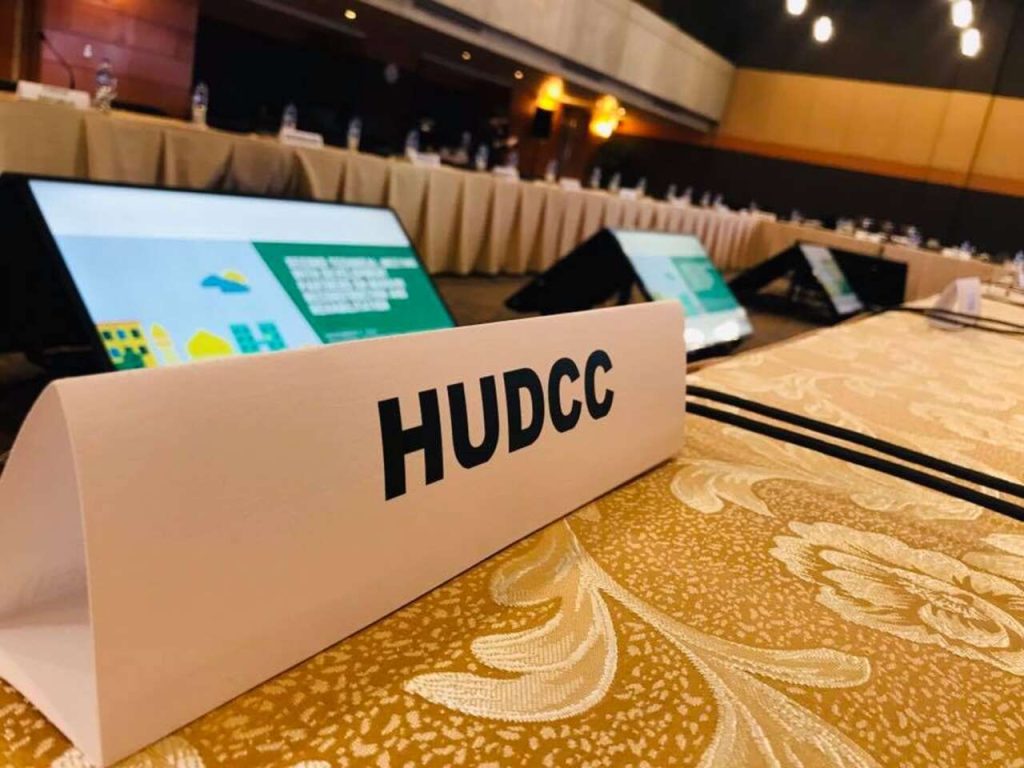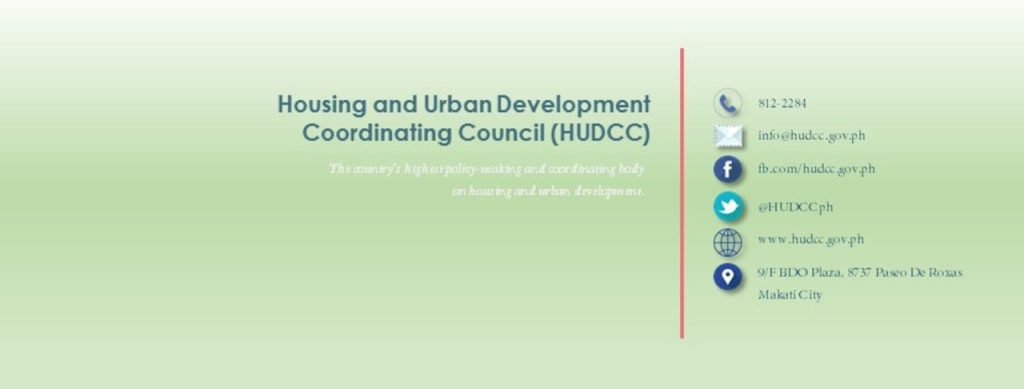The Housing and Urban Development Coordinating Council (HUDCC) was the Philippine government’s lead agency responsible for formulating and coordinating housing and urban development policies. Established through Executive Order No. 90 in 1986 under President Corazon C. Aquino, it aimed to address the country’s housing challenges, particularly for low-income families. HUDCC served as the central policy-making and coordinating body among various government shelter agencies, ensuring the implementation of effective housing programs.
In 2019, HUDCC was restructured to merge with another agency and to turn into the Department of Human Settlements and Urban Development (DHSUD) through Republic Act 11201. This transition from HUDCC to DHSUD was done to streamline housing efforts and programs under a single agency. Understanding HUDCC’s history and contributions is essential for grasping how Philippine housing policies have evolved over the years. In this article, we took a closer look at the HUDCC in an attempt to better understand how the agency performs to need updates
What Did HUDCC Do?

HUDCC managed the overall direction and strategies for the housing sector. Its main responsibilities included:
- Policy Formulation: Developing national objectives, policies, and plans for housing and urban development.
- Program Coordination: Overseeing housing programs implemented by government shelter agencies.
- Housing Finance Management: Ensuring the availability of funds for socialized and low-cost housing.
- Urban Renewal and Tenure Security: Supporting local government units (LGUs) in addressing housing issues.
- Monitoring and Evaluation: Assessing the performance of shelter agencies and recommending improvements.
- Private Sector Engagement: Encouraging the private sector to participate in housing initiatives.
History of HUDCC
HUDCC was established on December 17, 1986, through Executive Order No. 90. It was formed to take over the responsibilities of the abolished Ministry of Human Settlements and oversee the National Shelter Program.
Over the years, several executive orders expanded HUDCC’s mandate:
- Executive Order No. 357 (1989) and Executive Order No. 20 (2001) granted HUDCC authority to supervise key housing agencies and coordinate national housing objectives.
- Republic Act 7279 (Urban Development and Housing Act of 1992) required HUDCC to lead the formulation of a National Urban Development and Housing Framework.
- Various laws and executive orders reinforced HUDCC’s role in urban development, housing finance, and land use planning.
Transition to DHSUD
In 2019, Republic Act 11201 dissolved HUDCC and integrated its functions into the newly created Department of Human Settlements and Urban Development (DHSUD). DHSUD absorbed HUDCC’s policy-making and program-coordination functions, while the Human Settlements Adjudication Commission (HSAC) took over its regulatory and adjudicatory roles.
Logo

The HUDCC logo prominently features a stylized building-like structure with layered blue lines, symbolizing the agency’s focus on housing and urban development. The gradient blue color represents progress, stability, and trust, reflecting HUDCC’s role in formulating housing policies and coordinating shelter programs in the Philippines. Positioned beside the Republic of the Philippines’ Office of the President seal, it reinforces HUDCC’s authority as a government agency directly under the executive branch. The acronym “HUDCC” is in bold uppercase letters, ensuring strong visibility and recognition, while the full agency name, “Housing and Urban Development Coordinating Council,” is displayed in a mix of black and blue text, emphasizing key words related to its mission. Overall, the logo conveys housing security, policy leadership, and coordinated urban development efforts.
Mission
Now that the former HUDCC has merged with other agencies to become the new DHSUD, its mission as an institution is:
“To improve the lives of the Filipino people as the primary government agency in the management of housing, human settlements and urban development.”
Vision
Its operation is guided by the DHSUD vision which states that,
“A strong institution and catalyst for the provision of adequate and affordable housing, inclusive human settlements and well-planned communities for every Filipino family.”
Mandate
As an agency, the former HUDCC, now DHSUD, is mandated to:
- Act as the primary national government entity responsible for the management of housing, human settlement and urban development
- Be the sole and main planning and policy-making, regulatory, program coordination, and performance monitoring entity for all housing, human settlement and urban development concerns, primarily focusing on the access to and the affordability of basic human needs
Powers and Functions
HUDCC carried out various functions to support housing and urban development:
- Formulated national objectives for housing and urban development.
- Coordinated key government housing agencies in implementing housing programs.
- Monitored and reviewed shelter agency performance.
- Encouraged private sector participation in housing and urban development.
- Recommended housing-related legislation and amendments.
- Oversaw land use planning and asset management for housing.
- Facilitated financial assistance programs for home buyers and developers.
Organizational Structure
HUDCC was structured into several offices and groups, each handling specific functions to ensure efficient housing and urban development coordination. The Office of the Chairperson provided overall leadership and chaired the boards of Key Shelter Agencies (KSAs), while the Office of the Secretary General managed administrative and technical operations. The Deputy Secretary General Offices oversaw operational coordination, and the Policy Development, Legislation, and Special Projects Group (PDLSG) was responsible for formulating and reviewing policies. Performance assessment was handled by the Coordination, Monitoring, and Evaluation Group (CMEG), while legal concerns and anti-squatting initiatives fell under the Legal, Anti-Squatting, and External Affairs Group (LASEAG). Other essential units included the Asset Reform Group (ARG), which managed idle government lands for housing, and the Community Development Group (CDG), which focused on integrating informal settlers into communities. The Regional Operations Group (ROG) ensured the proper implementation of housing policies in regional offices, while the Administrative, Finance, and Knowledge Management Group (AFKMG) handled financial and administrative matters. These offices collectively worked to align national housing policies with government strategies, ensuring effective urban development across the country.
Key Shelter Agencies Under HUDCC
HUDCC worked with several government agencies responsible for housing and urban development:
- Home Development Mutual Fund (Pag-IBIG Fund): Provided housing loans and savings programs.
- Home Guaranty Corporation (HGC): Guaranteed housing loans for financial institutions.
- Housing and Land Use Regulatory Board (HLURB): Regulated land use and housing development (now part of DHSUD).
- National Housing Authority (NHA): Developed and managed government housing projects.
- National Home Mortgage Finance Corporation (NHMFC): Facilitated home financing for low-income groups.
- Social Housing Finance Corporation (SHFC): Implemented socialized housing programs.
Benefit
The establishment of HUDCC back when it was launched provided numerous benefits to the public, including the following:
- Improved Housing Policies: Streamlined and coordinated national housing programs to address the needs of low-income families.
- Affordable Housing Programs: Facilitated socialized and low-cost housing initiatives for underserved communities.
- Urban Development and Renewal: Promoted sustainable urban planning and infrastructure development.
- Security of Tenure: Assisted informal settlers in acquiring legal ownership of land and housing.
- Financial Assistance and Housing Loans: Enabled access to government-backed financing programs for homeownership.
- Stronger Coordination Among Shelter Agencies: Ensured seamless implementation of housing programs by overseeing key shelter agencies.
- Private Sector Engagement: Encouraged public-private partnerships to expand housing opportunities.
- Monitoring and Regulation: Established guidelines to protect homebuyers and ensure proper housing development.
- Disaster Resilience and Relocation Assistance: Provided housing solutions for disaster-affected and displaced communities.
Coverage
Then, HUDCC’s programs and services covered national housing policies, socialized housing programs, land use planning, urban renewal, and financial assistance for homeownership, ensuring low-income families and informal settlers had access to secure housing. It coordinated with government shelter agencies to implement resettlement programs, anti-squatting initiatives, and private sector partnerships for housing development. Now, under DHSUD, these functions continue with an expanded scope, integrating climate-resilient housing, disaster risk reduction, sustainable urban planning, and stronger financial mechanisms to support housing and urban development in the Philippines.
List of Programs and Services
HUDCC implemented several programs aimed at providing housing assistance and urban development:
1. National Shelter Program
A comprehensive housing program designed to provide affordable housing solutions for low-income families.
2. Socialized Housing Programs
Supported housing for informal settlers and low-income earners through various initiatives, including resettlement programs.
3. Urban Renewal and Tenure Security Program
Focused on rehabilitating urban areas and providing legal tenure to informal settlers.
4. Anti-Squatting Initiatives
Implemented policies to address squatting syndicates and promote fair housing policies.
Video: Understanding the DHSUD
HUDCC served as the primary government body coordinating housing and urban development policies in the Philippines for over three decades. It worked alongside government agencies, LGUs, and the private sector to address housing concerns, promote homeownership, and regulate land use.
Following the establishment of DHSUD in 2019, HUDCC’s functions were absorbed by the new department, which continues to oversee housing and urban development initiatives in the country. Understanding HUDCC’s legacy provides insight into the government’s approach to housing policies and programs in the Philippines. To learn more about this new department, you may check out this video from DHSUDgovph:
Contact Information
For updated housing policies and programs, or for any inquiries or other concerns, you may visit the Department of Human Settlements and Urban Development (DHSUD) or reach out to them via the following contact information:

Department of Human Settlements and Urban Development (DHSUD)
- Main Office Address: DHSUD Building, Kalayaan Avenue, corner Mayaman Street, Diliman, Quezon City, 1101
- Contact Information: 8424 40 70 | 0961-137-0196
- Email Address: info@dhsud.gov.ph
- Official Website: https://dhsud.gov.ph/
- Facebook: https://web.facebook.com/DHSUDgovph/
- Youtube: https://www.youtube.com/channel/UCoxr6_WNpG-kyATplwRbQIA
